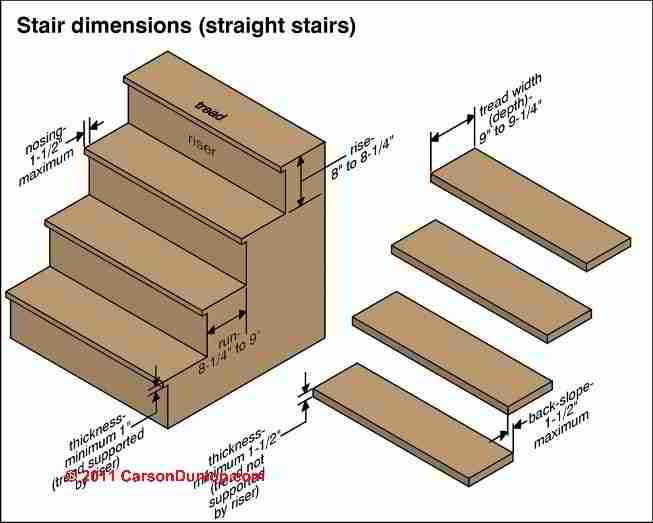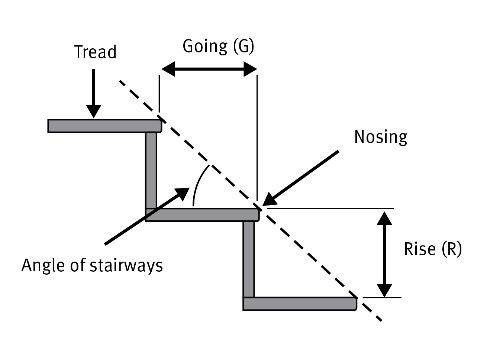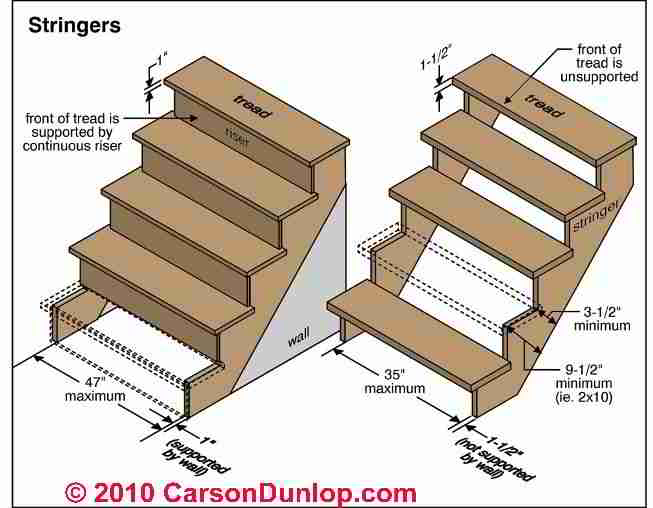minimum stair tread depth nz
Regularly check your tyres to make sure there is plenty of tread. BRANZ Guideline February 2012 stair widths.

Key Measurements For A Heavenly Stairway
According to the IBC stair tread depths must be a minimum of 11 inches on rectangular stairs.

. Rises must be a maximum of 190mm. Multiply the tread depth by the number of treads to calculate the overall length of the stair. There is always one more riser than treads so for 14 risers there will be 13 treads.
The tile floor shown at below left includes a 4-inch step up into a bathroom. Staircase risers should be adequately deep to allow a majority of your foot to have enough room to rest on the stair. Surfaces need to be slip-resistant under all conditions.
10 units Minimum Click image to download PDF Sheet. IBC 101152 requires that stair riser heights shall be 7 inches 178 mm maximum and 4 inches 102 mm minimum. Treads that project past the riser by at least 15 mm but not more than 25 mm to prevent toes being caught while walking up stairs.
However a small number of tyres such as some retreaded or vintage tyres may not have moulded tread-depth indicators. 300 13 3900 mm. 4121 Design for access and mobility Buildings and associated.
Nose of the step should be slightly rounded. The minimum permitted tread depth is 280 mm but with ample space for the stairs 300 mm treads have been selected. A tread depth of at least 275 mm.
NZS 142120018STAIRS 811 states in what building an accessible route is required Any stair or floor covering that is not rounded to 5mm min to 10mm max as shown in the diagram. The legal minimum tyre tread depth varies by each type of vehicle. Vehicle inspectors may disregard the outer end of a lateral groove where it.
In order to find out how the tread depth affects the tires performance the ADAC expert team conducted a test of 18560 R14 tires in a new condition tread depth being about 8 mm and in a used condition tread depth ranging from 75 to 4 mm. Minimum Stair Tread Depth Chart. Building Code compliance document D1AS1 does not specify a width for common or main private stairways the most common stairway applicable within residential buildings but recommends no less than 850 mm.
Stair treads need to be slip resistant and extend across the full width of the stairway. 41 Pitch risers and treads 27 42 Width 30 43 Landings 31 44 Curved and spiral stairways 33 45 Stair winders 33 46 Visibility of stair treads 33 50 Fixed Ladders 34 51 General 34 52 Step-type ladders 37 53 Rung-type ladders 38 54 Individual rung-type ladders 39 60 Handrails 39 Page 70 Doors and openings 43. Minimum stair tread.
Stair width of 9001100 mm. In group R-3 occupancies within dwelling units in R-2 occupancies and within group U occupancies that are accessory to group R-3. There is always one more riser than treads so for 14 risers there will be 13 treads.
Minimum permitted tread depth is 280 mm but with ample space for the stairs 300 mm treads have been selected. Internal stairs should have a minimum width of 1000mm. Depth no less than 031m and consistent for the entire flight measured from edge of step towards next riser.
What is the minimum stair tread depth allowed without a nosings on stairways with solid risers. Riser vertical section between treads Height of between 01m and 018m and consistent for the entire flight. BRANZ Guideline February 2012 stair widths.
Finishes include F5 off the form or may be diamond honed while maintaining NZ standards in slip resistance coefficients. This is especially the case for tyres that have lateral grooves those that end at the tyre edges as shown in Example 1 of Figure 7-1-3. B 11 inches From the 2015 IRC-R311753 Nosings.
Solid risers are required. This distance must be at least 10 inches. Or call us with your query on 0800 896 500.
NZBC Compliance Document Clause D1AS1 417 a Leading edges of treads or nosings if any on accessible stairways shall be rounded to avoid a sharp edge. Multiply the tread depth by the number of treads to calculate the overall length of the stair. Tread width must be a minimum of 1200mm.
For safe driving tires must be replaced at 3 or 4 mm remaining tread depth. For safe healthy and durable buildings all building work in New Zealand must meet certain standards. Maximum 7-34 inch stair riser height.
Slip resistant nosings can be added to meet these. Find out how to build within the rules. Minimum headroom is generally 2 metres.
Planning a successful build. Minimum 6-8 headroom height clearance for stairway. This floor height difference was observed in a New Zealand hotel.
Staircases must slope at an angle of 20 to 45 but between 30 and 38 is recommended. The faster you go the less effective your tyres will be if the tread depth isnt up to scratch. Health and safety on site.
OSHA 191025 c 2 requires standard stairs to h ave a maximum riser height of 95 inches 24 cm. Tread depth must provide adequate footing and be a minimum of 280mm. Adequate tread depth is essential for stairway safety.
This means that in order to pass a WoF or CoF some tyres must have 15mm tread depth across a greater tread width than other tyres. The riser height which is the distance between the leading edges of treads following each other must be a. The tread depth can go to any maximum as long as the maximum tread in a stairway does not exceed the smallest by over 0375 inches.
Analysis of stairway related. The image below shows how much a tyre touches a wet road at different speeds. No overhang at the edge of the tread.
Multiply the tread depth by the number of treads to calculate the overall length of the stair. D Nosings are always required. Single treads have been designed in many different profiles.
Minimum 10 inch stair tread depth with nosing or Minimum 11 inches with no nosing. Stairs and 300mm plus one tread depth 310-450mm past the bottom of the stairs. Treads that are all at the same width.
However the ICC notes that if the steps do not have nosings and the steps have solid risers not open risers the minimum tread depth is 11 inches. 285 to 380. Maximum 12-7 vertical height rise for a flight of stairs.
Stair treads must have uniform rise within each flight and across consecutive flights a 5mm difference can make stairs unsafe. The edge of treads should be visible against the background. The minimum permitted tread depth is 280 mm but with ample space for the stairs 300 mm treads have been selected.
300 13 3900 mm Each tread will also have a. When designing stairs factors to consider are the design parameters given in D1. Maximum 4-12 inch handrail projection into stairway width on either side.
Even step heights risers the riser height plus one tread depth should be in the 580 mm to 620 mm range. 2 Standards New Zealand 2001. A tread depth of at least 275 mm.
Because the same color tiles were used on the floors at both levels as well as on the step riser it is very difficult to see that there is a step especially in low light. The legal minimum in NZ and Australia is 15mm. The radius of curvature at the nosing shall be no greater than 916 inch 14 mm.
External stairs should have a minimum width of 1200mm. Avoid accidents and make site safety a priority. The minimum legal depth is 15mm but the more tread you have the better the grip and the safer youll be.

Typical Residential Stair Plan Drawing Google Search Stair Plan Stairs Floor Plan Architectural Floor Plans

Deck Stairs Deck Stair Stringer Stairs Stringer

Requirements Of Staircases General Guidelines About Heights Headroom Treads And Risers The Constructor

Stair Tread Depth Specific Inspection Topics Interior Inspections Internachi Forum Stairs Treads And Risers Stair Treads Stair Dimensions

Inspecting Stair Stringers Internachi

Framing A Staircase Fine Homebuilding Article Stairs Design Stairs Building Stairs

Stairway Tread Width Tread Nose Details For Stair Construction Inspection
Osha Stair Requirements To Keep Your Workplace Safe And Productive

Angles For Different Types Of Stairs Engineering Discoveries Types Of Stairs Stair Plan Stair Angle

Stair Dimensions Staircase Railing Sizes Guide Designing Idea

Stair Dimension Stair Dimensions Stairs Treads And Risers Stair Layout

Standard Dimensions For Stairs Engineering Discoveries Stairs Home Stairs Design Building Stairs

Requirements Of Staircases General Guidelines About Heights Headroom Treads And Risers The Constructor

Safe Design And Use Of Stairs Worksafe Qld Gov Au

Inspecting Stair Stringers Internachi

Stair Stringer Stair Tread Support Defects Hazards


